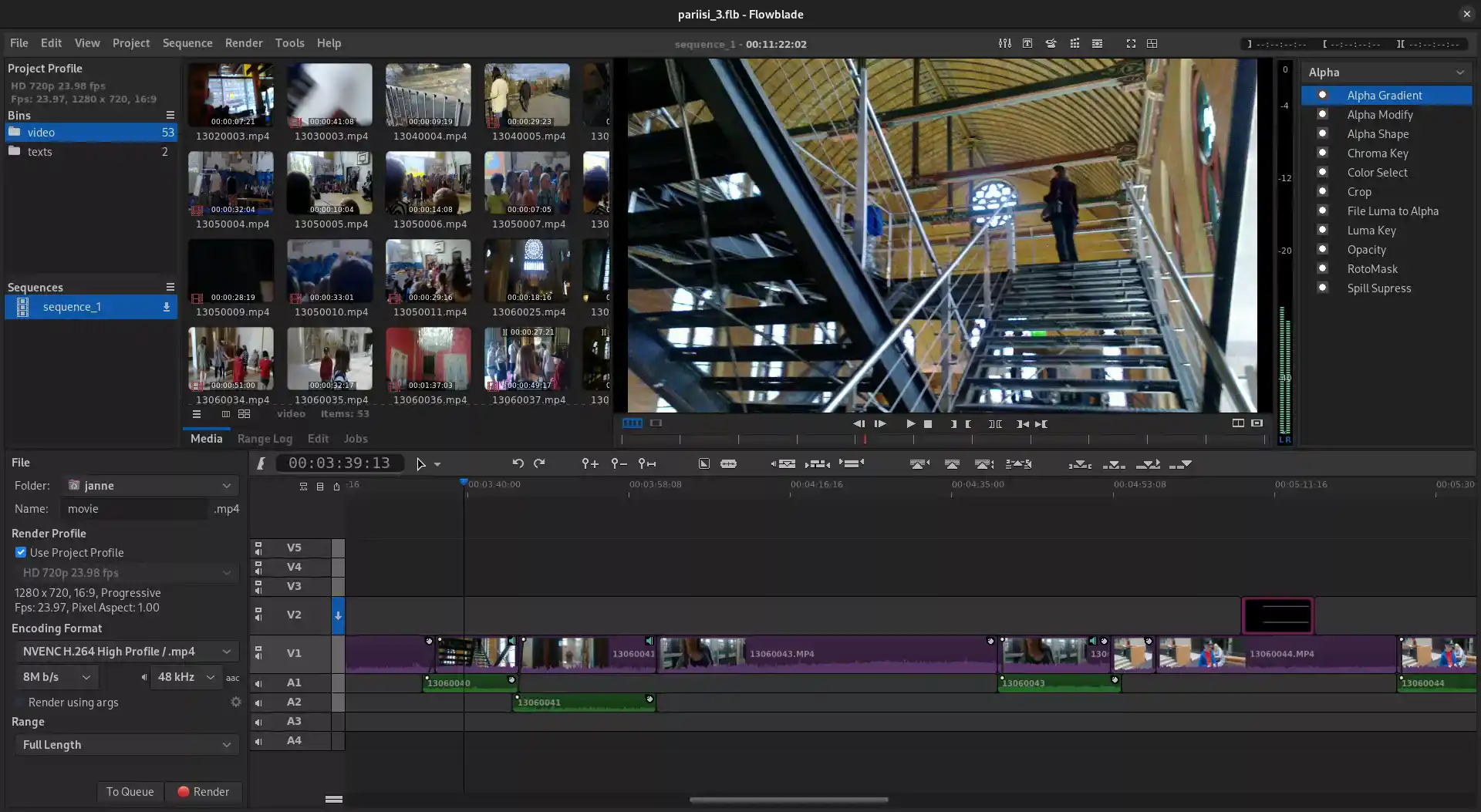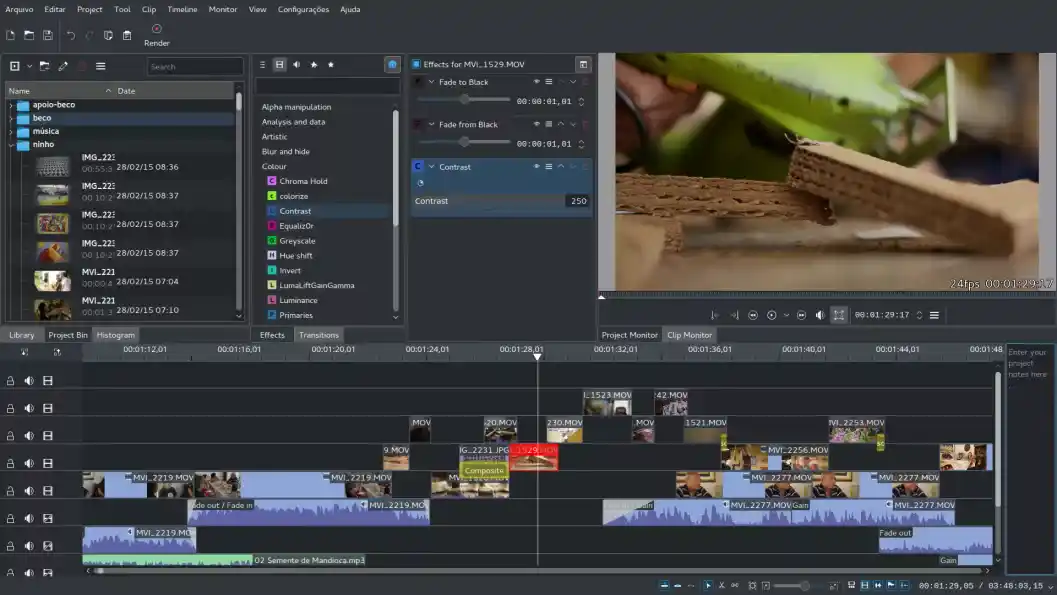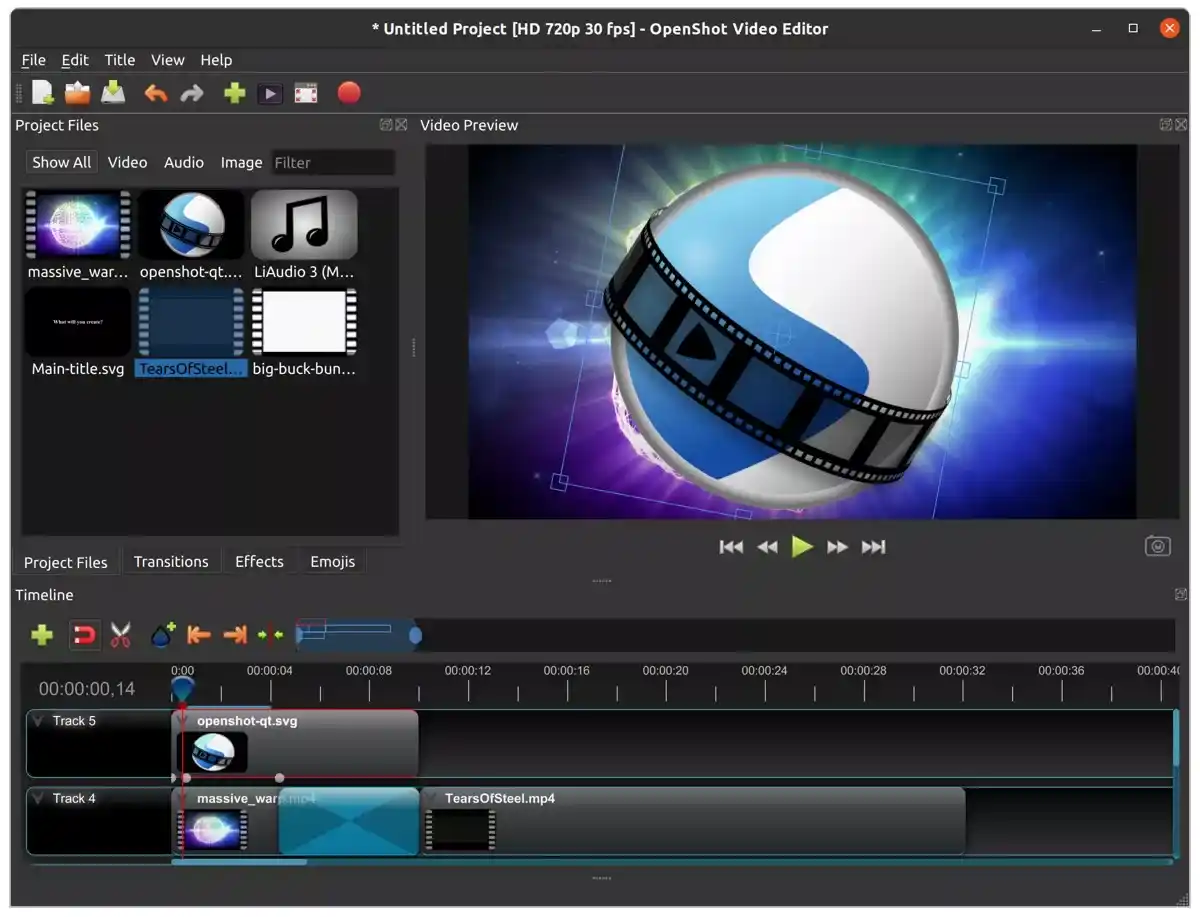Table of Contents
In today’s digital age, video content is king. Whether you’re a content creator or marketer, having access to high-quality video editing software is essential. While there are many paid options available, free open-source video editing software offers powerful features without the hefty price tag. In this article, we’ll explore the top 5 free open-source video editing software available in 2024. These tools are not only free but also provide a robust set of features for both beginners and professionals.
An open-source video editor allows users to create, edit, and manipulate video files. The source code of these programs is freely available for anyone to inspect, modify, and enhance. This means that a community of developers can contribute to the software, ensuring continuous improvement and updates. Open-source video editors are often free to use, making them an excellent choice for those who need powerful video editing tools without the associated costs.
Benefits of Open-Source Software for Businesses
Open-source software offers a myriad of advantages that are increasingly being recognized by businesses as outweighing those of proprietary software. According to Forrester, 57% of companies adopt open-source solutions to cut costs, 55% to enhance development team efficiency, and 54% to facilitate their IT infrastructure’s shift to the cloud.
Here are some specific ways in which open-source software can benefit organizations:
1. Digital Transformation
Many businesses still struggle with digital transformation, which is essential for future success. Open-source software facilitates this transition by being cost-effective and highly adaptable. These solutions are often free, making them accessible to businesses of all sizes. Moreover, the customizable nature of open-source software allows companies to tailor it to their specific requirements, creating a seamless digital workplace.
2. Unmatched Transparency
The transparency provided by open-source software is a significant advantage. Users can access and modify the source code, ensuring there are no hidden functionalities. This transparency is crucial for security, as it allows users to inspect and enhance the code to meet their security standards.
3. Advanced Security
One of the primary reasons businesses choose open-source software is its superior security. With a large community of developers scrutinizing the code, vulnerabilities are quickly identified and addressed. This collective effort ensures a higher level of security compared to proprietary software, where fewer eyes are on the code.
4. Reduced Costs
Open-source projects can significantly reduce overall IT expenses, freeing up resources for other critical areas like data protection. Despite the ideal cybersecurity spending being 14% of the total IT budget, companies typically allocate only 6%. Open-source software, being cost-effective, helps bridge this gap by lowering overall spending.
5. Community Engagement
The open-source community is vibrant and collaborative, with many developers eager to contribute to and improve projects. This communal effort leads to continuous enhancements and high security standards. For instance, Rocket.Chat’s community of 30,000 members on GitHub plays a crucial role in its software upgrades and maintaining its security.
6. Rapid Security Updates
The collaborative nature of open-source software ensures that security updates are implemented swiftly. This rapid response is essential for preventing potential exploits and keeping up with evolving data privacy regulations. Users can rely on the community to quickly address any security vulnerabilities.
7. Cost-Effectiveness
Open-source software is often free and serves as a viable alternative to expensive proprietary software. Even when there are paid versions of open-source software, they are usually more affordable than their proprietary counterparts, making them a cost-effective choice for businesses.
8. Customization
The ability to customize open-source software is a significant benefit. Access to the source code allows businesses to modify and enhance the software to suit their specific needs. This flexibility is particularly valuable for companies that require unique functionalities or need to make small adjustments to optimize their workflows.
In summary, open-source software provides numerous benefits, including cost savings, enhanced security, transparency, and the ability to customize and adapt the software to specific needs. These advantages make it a compelling choice for businesses looking to innovate and improve their operations.
5 Best Open Source Video Editing Software
| Program | Platform | Key Features | Interface | Our Rating |
|---|---|---|---|---|
| Blender | Linux, macOS, Windows | VFX, modeling tools, animation tools, draw in 2D/3D | Customizable, complex | 4.5/5 |
| Flowblade | Linux | Good format support, lightweight | Simple, minimal | 4/5 |
| Kdenlive | Linux, macOS, Windows | Multi-track editing, customizable interface | Versatile, user-friendly | 4.5/5 |
| OpenShot | Linux, macOS, Windows | Keyframe animation, multi-track support, 3D titles | Intuitive, basic | 4/5 |
| Shotcut | Linux, macOS, Windows | Wide format support, 4K support, webcam capture | Customizable, resource-demanding | 4.5/5 |
Blender
Blender started as a 3D graphics package but has since grown to include video compositing and non-linear video editing capabilities. Initially known for its complex interface, Blender has significantly improved over the years, especially with version 2.8, which brought a user-friendly interface.

Key Features:
- VFX
- Modeling tools
- Animation tools
- Draw in 2D or 3D
- Several advanced features
Platforms Available On:
- Linux
- macOS
- Windows
Pros:
- Highly customizable
- Designed for 3D editing
Cons:
- Non-intuitive key shortcuts
- Takes time to master
Strength:
Blender is stable, fully cross-platform, and under steady development. While it’s primarily known for 3D modeling, the video sequence editor (VSE) is robust, with several plugins available to enhance its video editing capabilities. Blender’s VSE is optimized for basic editing tasks, making it suitable for integrating finalized shots into a final cut. With its high degree of customization and stability, Blender is a reliable choice for multimedia work.
Weakness:
Blender’s interface can be confusing for those expecting a traditional editing platform. Its rendering engines are optimized for 3D model rendering, making video sequence rendering slower compared to other editors. Additionally, the VSE lacks integration with the rest of Blender, and rendering a video sequence with effects can take significantly longer than other editors.
Flowblade
Flowblade is an open-source movie maker with an attractive interface and a strong selection of built-in filters for non-linear editing and video compositing. It uses FFMpeg for video encoding and decoding, allowing it to work with almost any media format.

Key Features:
- Good format support
- Lightweight
Platforms Available On:
- Linux
Pros:
- Supports multiple video formats
- Lightweight and fast
Cons:
- Available only for Linux
- No stabilization feature
Strength:
Flowblade offers a stable application for quick, no-nonsense cutting. Its workflow is efficient, making it suitable for professional-level editors who prefer a traditional cutting style. Flowblade’s minimal interface and robust functionality make it an excellent choice for editors who want to focus on the editorial process without distractions.
Weakness:
Flowblade’s interface might be overly simple for some users, and its keyboard shortcuts are not user-definable. Additionally, the lack of a stabilization feature can be a drawback for users needing advanced editing capabilities.
Kdenlive
Kdenlive has been around since 2003 and is designed to cover a wide range of video editing needs, from basic tasks to commercial work. It
was created with the Qt and KDE frameworks for Linux’s KDE desktop environment but is also available for Windows and macOS. Kdenlive is known for its versatility and user-friendly interface, making it a popular choice among both beginners and experienced video editors.

Key Features:
- Multi-track video editing
- Supports all audio/video formats with FFmpeg
- 2D title maker
- Customizable interface and shortcuts
- Proxy editing for faster performance
- Automatic backup
- Timeline preview
- Keyframeable effects
Platforms Available On:
- Linux
- macOS
- Windows
Pros:
- Can work with several video tracks
- Good audio editing capabilities
- Highly customizable
Cons:
- No auto-updates
- Occasional crashes
Strength:
Kdenlive is one of the most versatile open-source video editors available. Its multi-track video editing feature allows users to work on complex projects with ease. The customizable interface and extensive set of features make it suitable for both simple edits and advanced video production. Kdenlive also supports proxy editing, which makes it easier to work with high-resolution footage.
Weakness:
While Kdenlive is powerful, it can sometimes be prone to crashes, especially when handling large projects. Additionally, the software does not automatically update, which means users need to manually download and install updates to benefit from the latest features and improvements.
OpenShot
OpenShot is a user-friendly open-source video editor that offers a wide range of features for creating professional-quality videos. It includes advanced features like time-mapping and speed change capabilities, as well as the ability to create 3D titles and effects.

Key Features:
- Supports almost all video/audio formats
- Keyframe animation framework
- Multi-track support
- Desktop integration (drag and drop support)
- Video transition with real-time previews
- 3D animated titles and effects
Platforms Available On:
- Linux
- macOS
- Windows
Pros:
- Supports 70 languages
- Can export video in 4K
Cons:
- Might be buggy
- Limited effects available
Strength:
OpenShot is known for its intuitive and easy-to-use interface, making it a great choice for beginners. The software supports a wide range of video and audio formats, and its keyframe animation framework allows for precise control over animations and transitions. The ability to export videos in 4K resolution is a significant advantage for users looking to create high-quality content.
Weakness:
OpenShot can be buggy at times, and users might encounter crashes or other stability issues. Additionally, while the software offers essential features, it lacks some of the advanced effects and capabilities found in other video editors.
Shotcut
Shotcut is a powerful open-source video editor that features a customizable interface and supports advanced monitoring and input. It offers a wide range of audio and video editing features and supports video resolutions up to 4K.
Key Features:
- Supports all major audio/video formats with FFmpeg
- Multiple dockable/undockable panels
- Intuitive UI
- JACK transport sync
- Stereo, mono, and 5.1 surround support
- Waveform, histogram, etc.
- Easy to use with dual monitors
- Portable version available
- Webcam capture
- Record from within the timeline for use-cases like voice-overs
- 4K support
Platforms Available On:
- Linux
- macOS
- Windows
Pros:
- Can capture webcam video
- Good format support
- Highly customizable
Cons:
- Intimidating interface for newcomers
- Resource-demanding
Strength:
Shotcut stands out for its extensive format support and advanced features, making it suitable for both basic and complex video editing tasks. The software’s customizable interface allows users to arrange panels according to their preferences, enhancing the editing workflow. Shotcut’s support for 4K video and its ability to capture webcam footage make it a versatile tool for various video production needs.
Weakness:
New users might find Shotcut’s interface intimidating due to its complexity and extensive features. Additionally, the software can be resource-demanding, which might affect performance on lower-end systems.
Related Article
Discover Supabase: The Top Open-Source Firebase Alternative
FAQ
Can I use free video editors for professional work?
Yes, many of the options mentioned in this article are powerful enough for professional video editing tasks, depending on your specific requirements. Software like Blender, Kdenlive, and Shotcut offer advanced features suitable for professional projects.
Can I contribute to open-source video editing software?
Yes, many developers welcome contributions from the community, including code contributions, bug reports, feature requests, documentation improvements, and translations. Open-source projects thrive on community involvement, and your contributions can help improve the software for everyone.
Are there tutorials available for learning how to use each program?
Yes, there are numerous tutorials available online for the most popular open-source video editors. These tutorials cover a wide range of topics from basic editing to advanced techniques, helping users of all skill levels get the most out of their chosen software.
Can I redistribute modified versions of the open-source video editing software?
Yes, under most open-source licenses, you are allowed to modify and redistribute the software as long as you comply with the terms of use, which may include providing attribution and sharing your modifications under the same license.
Is there a support team available?
Open-source video editors often have active communities of users and developers who provide support through forums, mailing lists, chat rooms, and other channels. While there may not be a formal support team, the community is usually very helpful in addressing issues and answering questions.
How do open-source video editors compare to paid software?
Open-source video editors can offer many of the same features as paid software, and in some cases, they can be more customizable and flexible. However, paid software might provide additional support, more frequent updates, and certain advanced features that might not be available in open-source alternatives.
Are open-source video editors safe to use?
Yes, open-source video editors are generally safe to use. Since the source code is publicly available, it can be reviewed and audited by anyone, which helps ensure that there are no malicious elements. However, it’s always important to download software from reputable sources to avoid any potential security risks.
Wrapping Up
So now that you know about some of the most popular open-source video editors available, what do you think about them? Are they good enough for your professional requirements? Did we miss any of your favorite open-source video editors that deserved mention?
Free video editing software is a great alternative to expensive and often complicated programs. With their wide range of features, these options are perfect for beginners and professionals alike. Not only do they provide a cost-effective solution, but they also foster community collaboration and improvement. With continuous updates and contributions from developers all over the world, these projects are constantly evolving and improving.
Ultimately, the best free open-source video editor for you will depend on your specific needs, preferences, and level of expertise. Dive into these tools, explore their features, and find the one that best fits your video editing workflow. Happy editing!